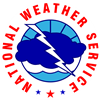Overview
|
July 15, 2020 is the 40th anniversary of one of western Wisconsin's worst windstorms, which hit during the evening of July 15, 1980. The southern Twin Cities suburbs were also hit hard. Sadly, there were four deaths (three in Wisconsin and one in Minnesota). |
Upper Air Chart
 |
| Upper level map (500 millibars or about 18,000 feet above sea level) from 7:00 a.m. CDT July 15, 1980. There is a significant trough across the northern Rockies. The black lines directed from west-southwest to east-northeast are somewhat tightly grouped, indicating faster wind speeds in this area. Both the trough and faster wind speeds aloft would be important in the development of the severe storms. |
Radar
You can view the radar loop at this link along with some detailed explanations of the radar and the damage.
 |
| MSP radar image at 0224z (9:24 p.m. CDT) showing the bow echo that has just reached Eau Claire. |
Model Simulations
We ran a special computer model using data from 1980. A research model, the HOPWRF, was run using data from 7:00 a.m. on July 15, 1980, and select forecast graphics are posted below. More information on the model is available at this link.
 |
| Image from the 7:00 a.m. HOPWRF model shows a prediction of 90-115 mph winds near the jet stream level at 7:00 p.m. The level shown here is actually at 250 millibars, or about 35,000 feet above sea level, and does not represent the exact jet stream level. The strong winds aloft just north of the devastated area was very important to the development of the severe storms. |
 |
|
The above image from the 7:00 a.m. HOPWRF model shows a prediction of wind gusts greater than 80 mph at 9:45 p.m. CDT. The timing is slightly off, but the intensity and location is very close to what actually happened. |
|
|
| The above image from the 7:00 a.m. HOPWRF model shows a prediction of 60-75 mph wind gusts at 11:15 p.m. CDT. The timing is slightly off, but the intensity and location is very close to what actually happened. This is pretty remarkable for a model using data from 1980.​ |
 |
| The above image from the 7:00 a.m. HOPWRF model shows a prediction of the weather map at "mean sea level" at 7:00 p.m. The closed contour in eastern South Dakota represents the forecast position of the low pressure system, and this was very close to what actually happened. One can also infer a warm front extending eastward across southern Minnesota. This setup helped maintain the storms as the moved from South Dakota into Wisconsin. |
 |
| The above image from the 7:00 a.m. HOPWRF model shows a prediction of radar at 9:45 p.m. CDT. The timing is slightly off, but the intensity and location is very close to what actually occurred. |
 |
|
The above image from the 7:00 a.m. HOPWRF model shows a prediction of radar at 11:15 p.m. CDT. The timing is slightly off, but the intensity and location is also very close to reality. |
Other Summaries on this Event
NWS Twin Cities Facebook page at https://www.facebook.com/
NWS Twin Cities on Twitter at https://twitter.com/
The storm was also documented in the 2005 book "Spearhead Echo, the Storm of 1980" by Lukas Hoffland. Hoffland also created a Facebook page at https://www.facebook.com/TheStormOf1980/
WEAU-TV produced a documentary in 1981. It can be viewed at https://www.youtube.com/watch?v=Hnmp9YI6OMo
 |
Media use of NWS Web News Stories is encouraged! Please acknowledge the NWS as the source of any news information accessed from this site. |
 |